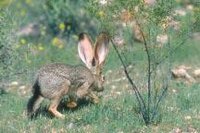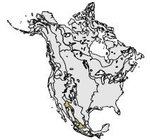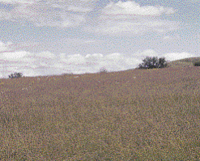Southern Semi-Arid Highlands ecoregion (CEC)
This region extends over part of the states of Arizona and New Mexico in the United States, and southward over several states in northern, western and central Mexico. In Mexico, this region is bounded on the west by the Temperate Sierras and on the east by the North American Deserts ecological region. The landscape is composed of hills, bottom valleys and plains. In general, the vegetation within this region is dominated by grasslands and in the transition zones by various scrublands and forests.
Physical Setting
This region is formed of alluvial sediments and conglomerates from the volcanic sierras: the Western Sierra Madre and the Neovolcanic system. The elevation above sea level ranges from 1,100 to 2,500 meters (m). There are two major types of soils, those that are relatively dry and moderately deep, and those that are shallow, clay soils. The climate is semi-arid, with 300-600 millimeters (mm) of annual rainfall and mean temperatures ranging from 12 to 20°C. In winter, frosts are common, as are periodic droughts.
Biological Setting

The characteristic natural vegetation, which presently is very diminished or altered, consists of grasslands and combinations of grasslands with scrublands and forests in the transition zones. Certain species of grasses are dominant, particularly blue-stemmed, threeawn, galleta, and muhly grass. Among the shortgrasses, blue grama is an important species in the region at the foot of the Western Sierra Madre in the states of Chihuahua, Durango and Zacatecas. Among the shrubs and trees, in some locales, Aguascalientes, Jalisco and other places, it is very common to see mesquite and acacia associated. Oak and western juniper are common at the foot of the sierras. On deep clay soils, mesquite groves are the most conspicuous plant community. Over igneous hills in the Bajio region, where the climate is warmer, one finds subtropical scrublands, with species like cazahuate or palo bobo, copalillos, acacia, prickly pear, jonote and pochote. Wildlife includes quail, pigeons, doves, hares, jackrabbits, coyote, gray fox, mule deer, whitetailed deer and pronghorn antelope.
Human Activities
The population in this region is about 10 million. This amounts to 8 percent of the population of Mexico. Raising livestock (cattle, horses and goats) has always been a very important activity in this region. Overgrazing has degraded the original plant and wildlife communities, with a serious reduction in plant cover and species composition along with changes in the structure of the plant community, mainly through shrub species invasion and soil erosion. Flatlands are used for irrigated agriculture. The main crops include beans, corn, sorghum, garlic, onion, hot peppers, vegetables, nuts, apples and peaches. There are several agro-industries, most notably those relating to milk and dairy products. Important mining activities include silver, gold, lead, copper and iron extraction. Several industrial and economically important cities have also developed.
| Disclaimer: This article is taken wholly from, or contains information that was originally published by, the Commission for Environmental Cooperation. Topic editors and authors for the Encyclopedia of Earth may have edited its content or added new information. The use of information from the Commission for Environmental Cooperation should not be construed as support for or endorsement by that organization for any new information added by EoE personnel, or for any editing of the original content. |



